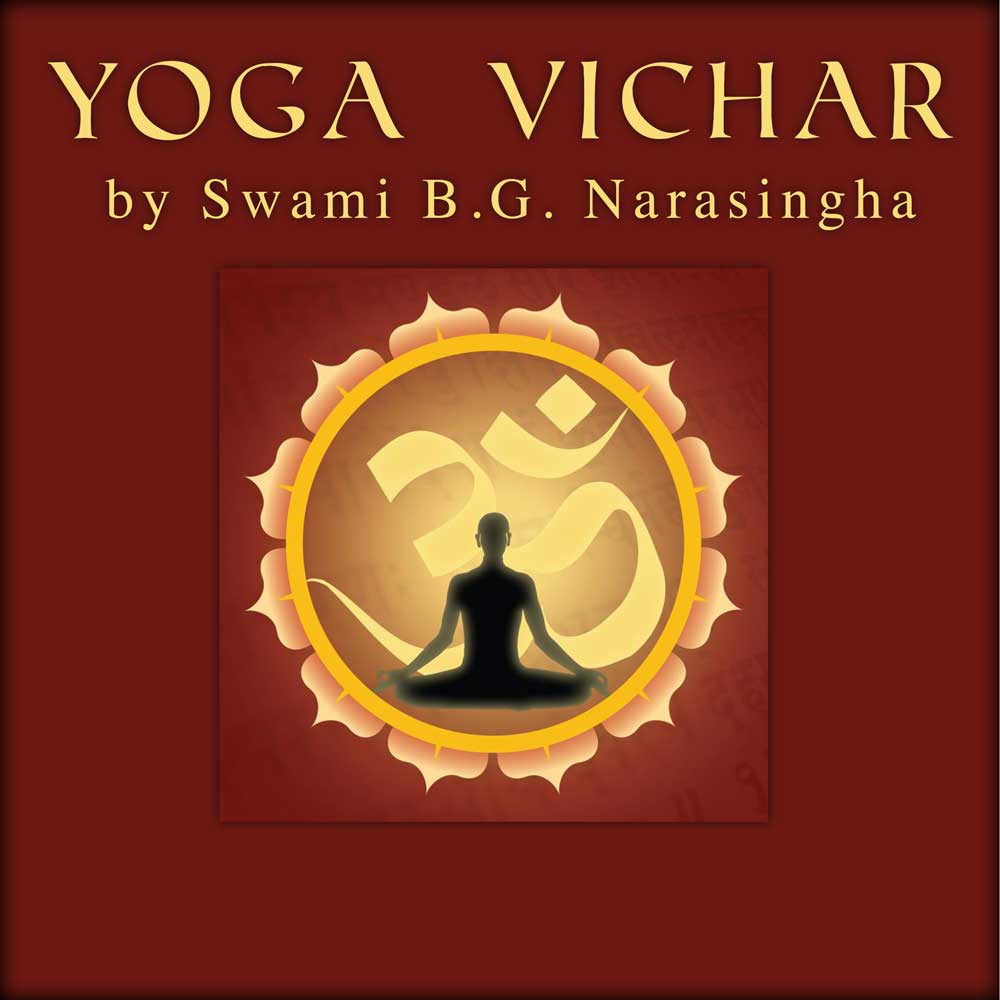Abhyasa – Constant and dedicated spiritual practice.
Acharya – A self-realised spiritual master.
Akarma – Devotional activities performed solely for the service of Krishna.
Ananda – Transcendental bliss.
Aniruddha – An expansion of Krishna.
Ashram – A spiritual sanctuary for self-realisation.
Ashtanga-yoga – The eightfold yoga system expounded by the sage Patanjali.
Atma – The individual unit of consciousness.
Avatara – A manifestation of Krishna, appearing in different forms.
Balarama – The first expansion of Krishna.
Bhagavad-gita – The ancient Sanskrit yoga treatise spoken by Sri Krishna to His friend Arjuna.
Bhagavan – The personal and most complete aspect of the Supreme.
Bhagavata – The Bhagavata Purana, one of the most important books in bhakti-yoga.
Bhakti – Devotion to Krishna.
Bhakti-yoga – The yogic process of devotion towards Krishna.
Brahma – The first living being in the universe and secondary creator.
Brahman – The impersonal effulgence emanating from the body of Krishna.
Brahmana – A Vedic priest and teacher.
Brahma-samhita – An ancient Sanskrit texts containing the prayers of Brahma to Sri Krishna.
Chatur-vyuha-tattva – The fourfold manifestations of Krishna in Vaikuntha.
Chaitanya–charitamrita – A biographical book about the life and teachings of Chaitanya Mahaprabhu.
Chaitanya Mahaprabhu – The avatara of Sri Krishna who appeared in India in the 15th Century to teach bhakti-yoga.
Chanakya – A famous ancient Indian statesman and scholar of the 4th Century BCE.
Chanakya Niti-Shastra – A book containing aphorisms concerning social and moral behaviour by Chanakya.
Dakshina – A traditional gift of gratitude from a student to a teacher.
Devanagari – The Sanskrit script.
Dhyana – Meditation.
Diksha – Initiation into a sacred mantra.
Gayatri – A Vedic mantra glorifying the Supreme Truth.
Goloka – The topmost spiritual planet where Krishna eternally resides.
Gopala – Sri Krishna, the cowherd boy of Vrindavana.
Gopala-mantra – The 18 syllable mantra invoking Sri Krishna.
Gopala-Tapani Upanishad – An Upanishad glorifying Sri Krishna and His abode.
Govinda – A name of Krishna, meaning ‘the Lord of the cows and the material senses.’
Ishvara – The Supreme Controller, Sri Krishna.
Jagannatha Puri – A holy city in Orissa, East India.
Kama-gayatri – A Vedic hymn describing the beauty of Sri Krishna.
Karma – The system of action/reaction. Karma also refers to activites that produce beneficial reactions.
Kirtana – Musical glorification of Sri Krishna.
Kusha – A perennial grass that grows in India and is considered sacred.
Lila – The divine pastimes of Sri Krishna.
Maha-mantra – The foremost mantra for deliverance in this age, comprising of the names of Krishna.
Maha-vakya – Great philosophical maxims from the Upanishads.
Mantra-dhyana – Meditation upon a mantra.
Mayavadi – A propounder of monistic philosophy.
Om (omkara) – The primeval spiritual sound vibration.
Padma Purana – An ancient Vedic text.
Padmasambhava – An 8th Century Indian Buddhist monk who brought Buddhism to Tibet.
Padmasana – The ‘lotus position’, a cross-legged yoga posture.
Paramatma – The manifestation of Krishna within the heart of all living beings.
Parampara – A disciplic succession of guru-disciple.
Patanjali – The author of the Yoga-sutras.
Pradyumna – A form of Krishna.
Pranayama – Controlling the breath, the seat of the life-airs.
Puranas – Ancient Vedic texts.
Sadhana – Spiritual practices.
Samadhi – The perfection of the yoga process.
Samsara – Repeated birth and death in the material world.
Shravana – The process of listening to mantras and spiritual topics.
Shyamasundara – A name for Sri Krishna meaning ‘One who has a beautiful dark complexion.’
Sridhara Deva Goswami – A famous 20th Century bhakti-yogi of the philosophical school of Caitanya Mahaprabhu.
Tantra – Mystical texts, generally in the mode of darkness.
Tapasya – Physical or mental austerities meant for spiritual attainment.
Radha – The principle consort and eternal potency of Sri Krishna.
Rig Veda – One of the four ancient Vedas.
Shiksha – Spiritual instructions.
Siddhi – Mystic powers.
Swami – A yogi in the renounced order of life.
Taraka-brahman – The name of the Absolute Truth that delivers one from repeated birth and death.
Upanishads – The section of the Vedas that deals with transcendental philosophy.
Vaikuntha – The spiritual world where Krishna and His avataras eternally reside.
Vedas – The four principle Vedas – the Rig, Yajur, Sama and Atharva.
Vedanta (see Vedanta-sutra)
Vedanta-sutra – The aphorisms that explain the end of all knowledge.
Vikarma – Activities that create detrimental results.
Vishnu – The avatara of Krishna; the cosmic preserver.
Vrindavana – The appearance place of Sri Krishna.
Yogashala – A place where yoga is practiced.
Yoga-sutras – The aphorisms on yoga by Patanjali Muni.
Yoga Yajnavalkya – An ancient treatise on yoga by the sage Yajnavalkya.
Yogeshvara – A name for Krishna, meaning the Master of Yoga.


